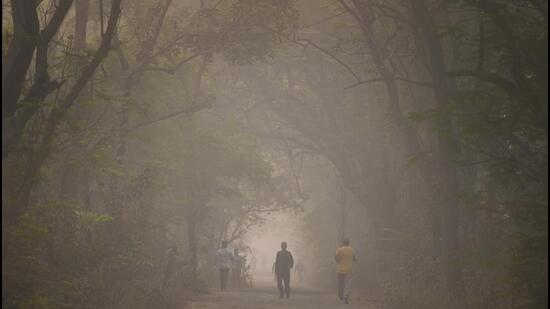Mumbai’s air quality tips close to ‘poor’ for sixth day in a row
Ozone and PM 2.5 were the primary pollutants for the first three and the latter three days in the six-day period, respectively
Mumbai: Mumbaikars woke up to a smog-engulfed winter morning on Sunday, the sixth consecutive day when the city’s 24-hour average air quality index (AQI) tipped dangerously close to ‘poor’, even as air quality in many locations within the city remained ‘very poor’ for several hours. Ozone and PM 2.5 were the primary pollutants for the first three and the latter three days in the six-day period, respectively, and prolonged exposure to these pollutants could cause irritation in the airways, worsening respiratory ailments and even causing such illnesses among normal people.

“Humidity in Mumbai is currently low while vertical wind speeds are high, which means that there are no water droplets to keep pollutants close to the ground. Instead, pollutants are pushed up until the inversion layer, leading to haze,” said Gufran Beig, chair-professor at the National Institute of Advanced Sciences (NIAS).
Sunil Dahiya, founder and lead analyst at Envirocatalysts, an environment focused research firm, said the primary source of pollution in Mumbai over the past six days was vehicular emission.
“Ozone is produced when nitrogen oxides in vehicular emission combine with atmospheric oxygen while PM2.5 comprises a cocktail of vehicular and industrial emission and small particles from machines at construction sites,” said Dahiya. Construction can be seen as the primary pollutant only when PM 10 levels rise as particles produced by construction activities are typically larger than PM 2.5, he explained.
Emissions from industries and power plants in the eastern suburbs of Mumbai as well as from neighboring areas like Thane, Mira Bhayandar, Panvel and Navi Mumbai also contributed to the recent spike in pollution, said the analyst. “Pollutants from neighbouring areas come within an airshed, and when the wind blows, the pollutants travel,” he said.
The spike in pollution could spell trouble for the entire population, although those with pre-existing respiratory illnesses were particularly vulnerable, said doctors.
“Ozone and PM2.5 particles – including carbon monoxide, nitrates and sulphates – cause irritation in the airways,” said Dr Priti Meshram, head of pulmonary medicine at JJ Hospital, Byculla. “Viral infections are also circulating, which makes the pollution worse.”
Prolonged exposure to pollutants like Ozone and PM 2.5 can exacerbate respiratory illnesses like Chronic Obstructive Pulmonary Disease (COPD) and even cause chronic cough, asthma and other illnesses among normal people. “The condition of asthmatics could become worse due to pollution, while those with COPD might deteriorate and require hospitalisation,” she said.
An official from the Brihanmumbai Municipal Corporation’s (BMC) environment department, whose focus has been on curtailing pollution from construction sites as per the Mumbai Air Pollution Mitigation Plan (MAPMP), said, “We have been encouraging citizens switch to electric vehicles (EV) and ensuring that our own fleet has at least 20% of EVs.” The civic body has asked bakeries to shift from coal and wood to cleaner fuels and all complaints regarding pollution are dealt with promptly by the solid waste department, the official added.
Experts, however, said the civic body must do more to address the spike in pollution, especially because Mumbai was located on the seashore, which encourages faster dispersion of pollutants.
“Even though Mumbai might be meeting the NAAQS (National Ambient Air Quality Standards) parameter for safe exposure to PM 2.5, the current levels could still harm people’s health,” said Dahiya. The NAAQS deems PM 2.5 levels up to 40 micrograms per cubic meter (µg/m³) as safe while the same as mandated by the World Health Organisation is 5 µg/m³. “Mumbai has the potential to do a lot better than it currently is,” said Dahiya.
Stay updated with all the Breaking News and Latest News from Mumbai. Click here for comprehensive coverage of top Cities including Bengaluru, Delhi, Hyderabad, and more across India along with Stay informed on the latest happenings in World News.
Stay updated with all the Breaking News and Latest News from Mumbai. Click here for comprehensive coverage of top Cities including Bengaluru, Delhi, Hyderabad, and more across India along with Stay informed on the latest happenings in World News.






